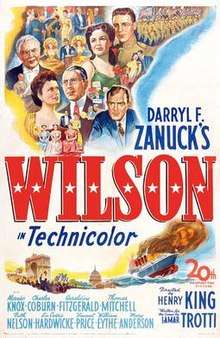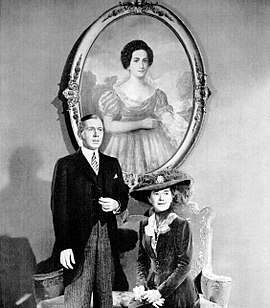Wilson (1944 film)
Wilson is a 1944 American biographical film about the 28th American President Woodrow Wilson directed by Henry King and starring Charles Coburn, Alexander Knox, Geraldine Fitzgerald, Thomas Mitchell and Sir Cedric Hardwicke. It was filmed on Technicolor.
| Wilson | |
|---|---|
 Film poster | |
| Directed by | Henry King |
| Produced by | Darryl F. Zanuck |
| Written by | Lamar Trotti |
| Starring | Charles Coburn Alexander Knox Geraldine Fitzgerald Thomas Mitchell Sir Cedric Hardwicke |
| Music by | Alfred Newman |
| Cinematography | Leon Shamroy |
| Edited by | Barbara McLean |
Production company | 20th Century Fox |
| Distributed by | 20th Century Fox |
Release date |
|
Running time | 154 minutes |
| Country | United States |
| Language | English |
| Budget | $2,995,000[1] |
| Box office | $2,000,000 (rentals)[2] |
Plot
In 1909, Woodrow Wilson is best known as the head of Princeton University and the author of several books on the democratic process. The local Democratic Party political machine convinces him to run for Governor of New Jersey. By the time of his successful election in 1912, Wilson has shown that he is his own man, not a functionary of the machine, and that he will fight for the truth at all costs.
As the U.S. is going through a progressive change in national politics and a split is developing in the opposing Republican Party, Woodrow Wilson is nominated in Baltimore and wins the Presidency in 1912. He pushes through a series of programs, called 'The New Freedom'. As World War I is breaking out in Europe in 1914, President Wilson tries to keep the U.S. neutral. At this same time, his wife Ellen dies of Bright's disease.
Overcome with grief and loneliness, the President, carries on. Early in 1915, at around the same time of the British trans-Atlantic passenger steamer Lusitania sinking, he meets Edith Bolling Galt, a Washington D.C. widow. A courtship develops and they find themselves in love and are married in December 1915. The next year of 1916 brings The President to reelection to a second term. Many feel that he is going to be defeated, and the result is so close that the balance hangs of the returns from California, which goes for President Wilson.
As, he starts his second term, the war finally comes to America. The Zimmerman note (Mexico and German alliance) is enough finally to put the U.S. in the war. The Yanks are coming, and in 1918 victory is on the side of the Allies. President Wilson travels to France to have a hand in the Peace treaty, but many Republican senators, including Henry Cabot Lodge, feel the President is leaving them out of the process, and make a decision to kill whatever treaty he brings back, or saddle it with reservations.
President Wilson takes the issue to the people in a multi state tour, but his health is broken on the trip and days after returning to Washington, has a stroke. Edith shields the President and screens visitors, and takes on a role that is controversial. But President Wilson recovers enough to make an orderly transition to President Warren G. Harding in 1921.
Cast
- Alexander Knox as Woodrow Wilson
- Charles Coburn as Professor Henry Holmes
- Geraldine Fitzgerald as Edith Wilson
- Thomas Mitchell as Joseph Tumulty
- Ruth Nelson as Ellen Wilson
- Sir Cedric Hardwicke as Senator Henry Cabot Lodge
- Vincent Price as William G. McAdoo
- William Eythe as George Felton
- Mary Anderson as Eleanor Wilson
- Ruth Ford as Margaret Wilson
- Sidney Blackmer as Josephus Daniels
- Madeleine Forbes as Jessie Wilson
- Stanley Ridges as Admiral Grayson
- Eddie Foy Jr. as Eddie Foy
- Charles Halton as Colonel House
- Thurston Hall as Senator E.H. Jones
- J. M. Kerrigan as Edward Sullivan
- James Rennie as Jim Beeker
- Katherine Locke as Helen Bones
- Stanley Logan as Secretary Lansing
- Marcel Dalio as Clemenceau
- Edwin Maxwell as William Jennings Bryan
- Clifford Brooke as Lloyd George
- Tonio Selwart as Von Bernstorff
- John Ince as Senator Watson
- Charles Miller as Senator Bromfield
- Francis X. Bushman as Bernard Baruch (uncredited)
- Davison Clark as Champ Clark (uncredited)
Production history
The movie was written by Lamar Trotti and directed by Henry King. Wilson's daughter, Eleanor Wilson McAdoo, served as an informal counselor.[3] Journalist Ray Stannard Baker, an authority on Wilson, served as an adviser.
Reception
Box office
The film lost a reported $2 million for Fox.[4]
Critical
Though the film was mostly critically acclaimed[5] and won five Oscars (see below), it is also remembered for being a big financial failure at the box office.
Film critic Manny Farber was particularly unenthusiastic, calling the production "costly, tedious and impotent" while writing: "The effect of the movie is similar to the one produced by the sterile post-card albums you buy in railroad stations, which unfold like accordions and show you the points of interest in the city ... The producers must have known far more about the World War, the peace-making at Versailles, and Wilson himself, but that is kept out of the movie in the same way that slum sections are kept out of post-card albums ... About three-quarters of the way through, a large amount of actual newsreel from the first World War is run off and the strength of it makes the film that comes before and after seem comical."[6]
Awards
Despite the negative press and lackluster box office, it was still nominated for 10 Academy Awards, winning five:
- Best Art Direction-Interior Decoration, Color (Wiard Ihnen and Thomas Little)
- Best Cinematography, Color (Leon Shamroy)
- Best Film Editing (Barbara McLean)
- Best Sound, Recording (E. H. Hansen)
- Best Writing, Original Screenplay (Lamar Trotti)[7][8]
Wilson was also nominated in the Academy Award categories for:
- Best Picture
- Best Director (Henry King)
- Best Actor in a Leading Role (Alexander Knox)
- Best Music, Scoring of a Dramatic or Comedy Picture (Alfred Newman)
- Best Effects, Special Effects (Fred Sersen and Roger Heman Sr.)
Wilson was notable for giving character actor Alexander Knox the title role, one of his few chances to play the lead in a film.
American president Franklin D. Roosevelt showed the film at the September 1944 Second Quebec Conference with British Prime Minister Winston Churchill. Churchill was unimpressed, however, leaving during the film to go to bed.
Despite being a pet project personally overseen by 20th Century Fox Studios' president Darryl F. Zanuck, who greatly admired Woodrow Wilson, its failure at the box office upset him to the point that for years he forbade his employees from mentioning the film in his presence.[8]
Wilson is sometimes shown on cable television, and was first broadcast on Turner Classic Movies on February 8, 2013.
Preservation
The Academy Film Archive preserved Wilson in 2006.[9]
References
- Solomon, Aubrey (1989). Twentieth Century Fox: A Corporate and Financial History. Lanham, Maryland: Scarecrow Press, p. 242, ISBN 978-0-8108-4244-1.
- Solomon, Aubrey (1989). Twentieth Century Fox: A Corporate and Financial History. Lanham, Maryland: Scarecrow Press, p. 221, ISBN 978-0-8108-4244-1.
- Knock, Thomas J. "History with Lightning": The Forgotten Film Wilson. American Quarterly, Vol. 28, No. 5 (Winter, 1976), pp. 523–543
- "You Can Sell Almost Anything", Variety 20 March 1946
- Codevilla, Angelo (2010-07-16) America's Ruling Class Archived 2011-02-25 at the Wayback Machine The American Spectator
- Farner, Manny, The New Republic, August 14, 1944
- "The 17th Academy Awards (1945) Nominees and Winners". oscars.org. Retrieved 2011-08-15.
- Erickson, Hal (Rovi). "Wilson (1944) – Review Summary". The New York Times. Retrieved 2014-02-22.
- "Preserved Projects". Academy Film Archive.
External links
- Wilson at the American Film Institute Catalog
- Wilson on IMDb
- Wilson at AllMovie
- Wilson at the TCM Movie Database
- Wilson at Rotten Tomatoes
